
King Salmon
The least abundant of the five species of North America’s Pacific salmon—albeit also the largest—the Chinook salmon range south from near Point Hope just north of Kotzebue Sound to the Islands of the Four Mountains in the Aleutian Chain and from there west across the Gulf of Alaska to Dixon Entrance. The species is most abundant from the southeastern panhandle north to the Yukon River, not far from Fairbanks. These northern fish are also unique as in the southern part of the species’ range, the fry often depart for the ocean during the first year of life, sometimes after spending as few as three months in their natal streams. Some Yukon River fish don’t abandon freshwater for the salt until year three. Another unique aspect to the Yukon fish is that they undertake the longest known freshwater spawning migration of any anadromous species, those going the farthest traveling from 1,500- to 2,000 miles to reach their spawning beds.
In the northwest region of Alaska, and the northernmost extent of the Chinook’s range, runs begin in mid-June and continue through mid-July, typically peaking somewhere near July 1. In the Interior, kings enter the Yukon River in June and reach the Canadian border by mid- to late July. The tributaries of the Copper River see their best Chinook angling from early to late July.
The fifth largest watershed on the continent, the Yukon, dominates the interior section of Alaska. But, due to the remote nature of most clearwater spawning tributaries and the long migrations the salmon undertake, less Chinook angling than one might think actually occurs in this region. Only in the Tanana Valley near Fairbanks is there sufficient road access to allow noteworthy sport-fishing effort.
A major tributary of the Yukon, the Tanana River has its source high in the Wrangell Mountains and flows some 500 miles north to rendezvous with the Yukon near Manley. Sport fishing for Chinook in the Tanana is chiefly accomplished in clear tributaries of the braided, glacial mainstem river. Most of the king salmon angling has historically taken place in the Salcha River, followed by the Chenaand Chatanika rivers. All three are accessible by car from Fairbanks, with the peak of the king season for the Salcha usually occurring in mid-July. Late July brings the best Chinook concentrations to the Chena and Chatanika rivers.
The best king salmon angling to be had in the interior area of the state, however, occurs farther south in the region dominated by the massive Copper River. The Copper supports a large and commercially important run of Chinook, but as with many of Alaska’s other large systems, the glacial nature of the river diverts much of the fishing opportunity to the drainage’s clearwater tributary streams
A total of 40 Chinook salmon spawning streams have been identified throughout the Copper River drainage, nine of which are surveyed by the Alaska Department of Fish and Game on a regular basis. In a 1999 study, these nine streams accounted for approximately one-quarter of the total escapement for the drainage, with the Gulkana River receiving about half of those fish, representing about 11.5 percent of the total Copper River escapement. The Gulkana begins with headwaters at the foot of the Alaska Range and flows through rolling hills on its way to meet the Copper River. A National Wild and Scenic River, the Gulkana supports the drainage’s most significant Chinook salmon sport fishery and accommodates anglers nicely, with most of the action taking place from the Middle Fork confluence down.
Again, taken from the 1999 ADF&G study, about 24 percent of all fish returning to the Copper River are bound for the Klutina River, which is a large glacial system, again meaning most of the best angling is found near the mouths of several clearwater confluences with the river. Klutina kings are larger than average, with fish over 50 pounds not beyond the realm of possibility and the river’s generally swift flows make landing these larger fish difficult if anglers are confined to the bank.
In general, Copper River Chinook returns begin in early June and extend through July. Peak times are earlier for the upper Copper River systems, as radio-tag studies have indicated that the fish traveling the farthest upstream tend to enter freshwater earlier than downstream stocks. For the Gulkana River, the height of the king salmon season is generally near the end of June and beginning of July. The Klutina River, like the Kenai, receives two separate (but not always distinct) returns of Chinook. The best times to fish the Klutina for kings is in early July and then again at the end of the month.
